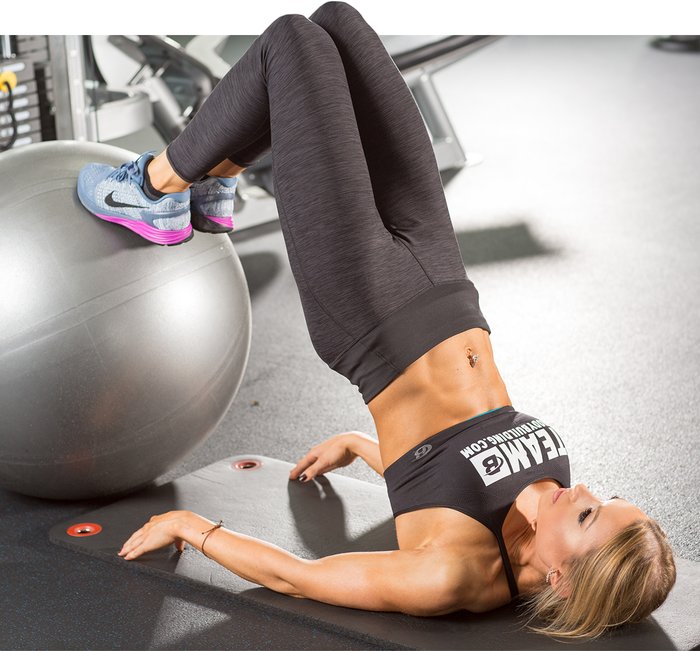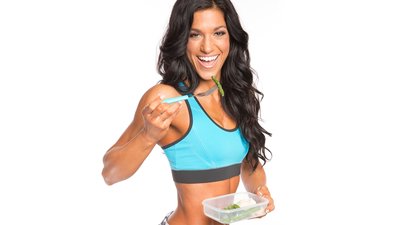Ask women in your average gym what they're doing to cut calories, and you'll get almost as many responses as there are women. But there's one common thread: Most are doing one form or another of dieting. Trying to improve your body composition while cutting calories can only get you so far, though. In fact, one of the best ways to get lean is to eat more, not less. Here's how it works.
A Winning Strategy: Replace Fat with Muscle
You might have heard of "spot reduction," a wonderful fantasy that you can use all manner of gimmicks to lose weight in specific body parts (your ass, your thighs, your arms) and bring them into conformity with the rest of your body. Not so much.
One of the best ways to improve your physique is to reduce your overall body fat while building up muscle in those areas you're working on. And to build muscle, you need to eat the right amount of the right foods.
Contrary to what many diet plans claim, you can't starve yourself to a better body. First of all, it's physically impossible to grow muscle when you're not getting enough calories. If, for example, your feel like your thighs are too fat, the best thing you can do is quad and hamstring exercises and start replacing all that body fat with muscle. But to build muscle, you need to eat.

Try it for yourself. Do a workout when you're hungry, then do one an hour or two after you've had a good, balanced meal. Which one felt like a better workout? It's not rocket science: Consume enough calories, and your body has the energy it needs to power your workout.
Consume less than you need, and you're more likely to slog through your routine, doing fewer reps with lighter weights. When your goal is, as it should be, to get lean—not skinny—you need fuel!
How to Burn More Calories In and Out of the Gym
Getting the calories you need is like shovelling coal into your body's furnace. You're able to stoke a glowing hot fire that can propel you down the track. But what's even cooler—or, hotter—is that by increasing that metabolic fire in your belly when you work out, you're also keeping that fire burning for hours afterward.[1]
One way to talk about this increased metabolic rate is to talk about non-exercise activity thermogenesis (NEAT). This is the amount of energy you burn for less-obvious activities such as maintaining your posture, walking to work, gardening, shoveling snow—even typing or fidgeting. NEAT activities included just about everything we do except sleeping, eating, or doing what we normally consider "exercising."
A study found that when non-obese people consumed extra calories over an eight-week period, they were able to burn off those calories through increased NEAT activities.[2] It's all about staying active and keeping that furnace in your belly burning hot and steady.
No, It Doesn't Mean That!
"So, wait," you ask, "Does this mean I can eat more and my body is just going to burn more calories as a consequence? Sounds too good to be true!"
It is. The basic laws of the conservation of energy still apply: If you don't burn as many or more of the calories you consume, those calories will stick with you in the form of body fat.

Your goal instead should be to consume a "sufficient" amount of food, which is much more sustainable over the long run that not eating enough food. Eating a sufficient amount of food means you aren't feeling constantly preoccupied by food the way you might be if you're on a restrictive diet.
It means you have some flexibility and aren't limited to a short list of food choices. Instead, you are able to eat a variety of foods each day, including restaurant meals, and don't feel like you have to prep every single meal or settle for bland food.
Simply put, a sufficient amount of food is one that you can live with comfortably for many years without feeling deprived. Sounds good, doesn't it? And it's completely within your grasp—as long as you understand that the way to improve your physique is to focus on building lean muscle rather than losing body fat.
It can be a gradual process. As you exercise more, you'll see that you need to eat more to keep your energy levels up. In time, once you gain lean muscle and lose fat, you may well find that you can't eat enough. Now wouldn't that be a good problem to have?
References
- Stiegler, P., & Cunliffe, A. (2006). The role of diet and exercise for the maintenance of fat-free mass and resting metabolic rate during weight loss. Sports medicine, 36(3), 239-262.
- Levine, J. A., Eberhardt, N. L., & Jensen, M. D. (1999). Role of nonexercise activity thermogenesis in resistance to fat gain in humans. Science, 283(5399), 212-214.

